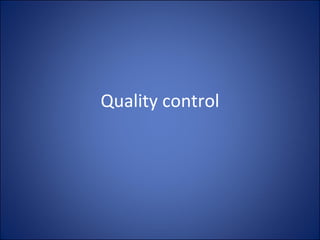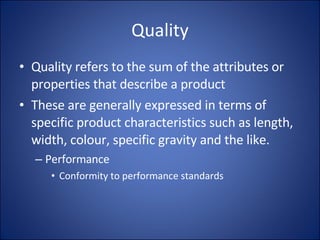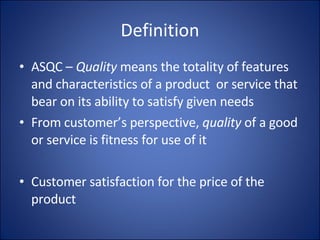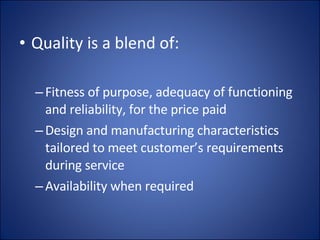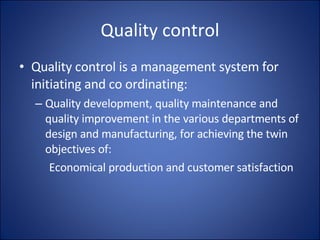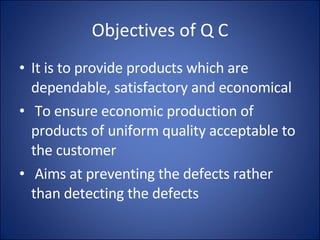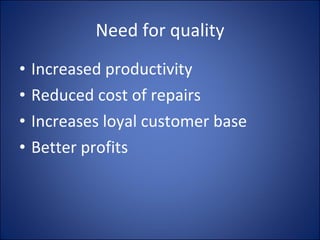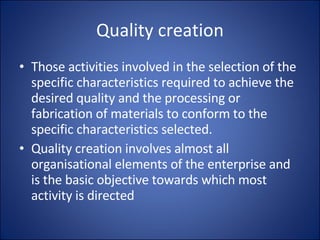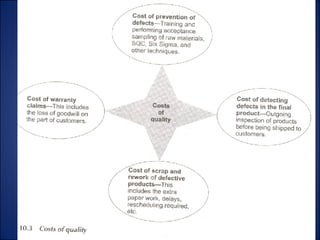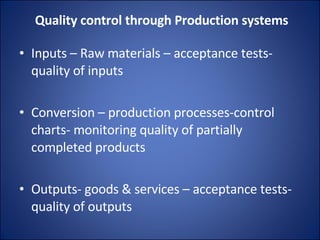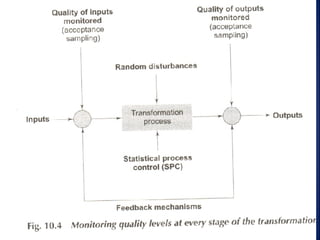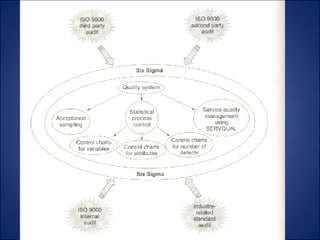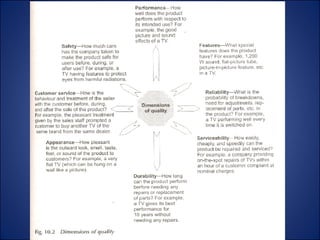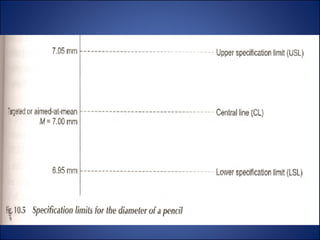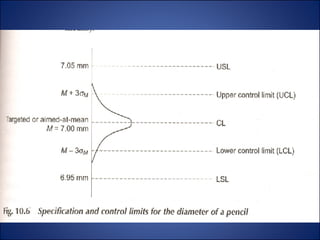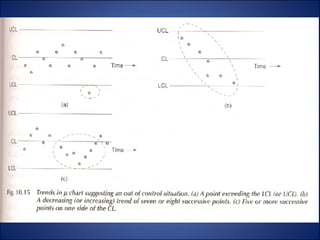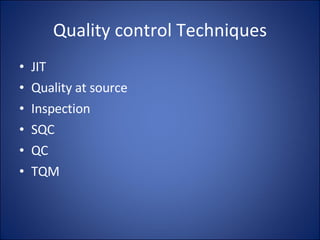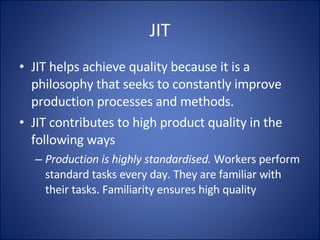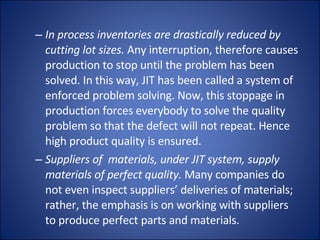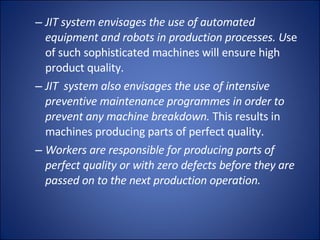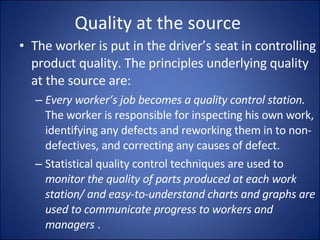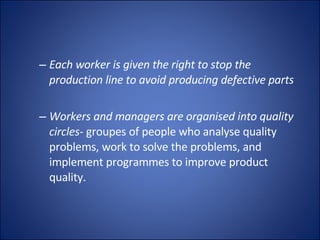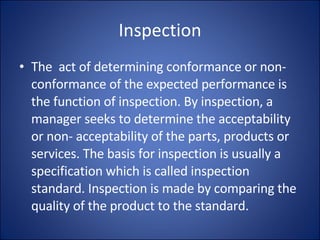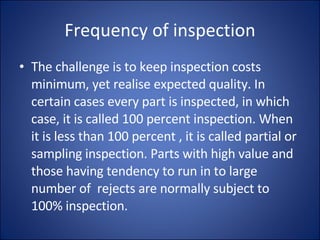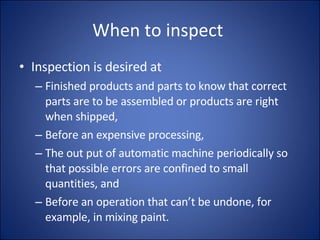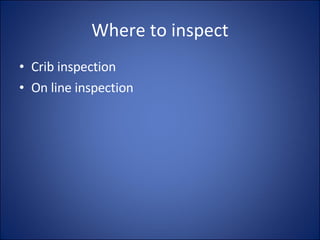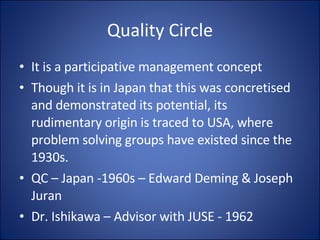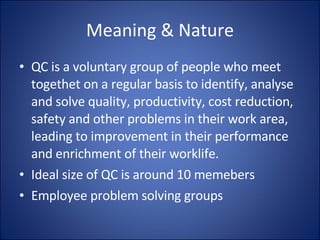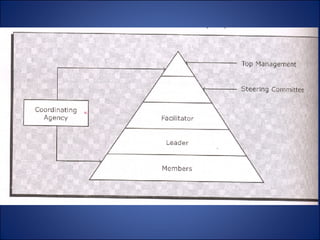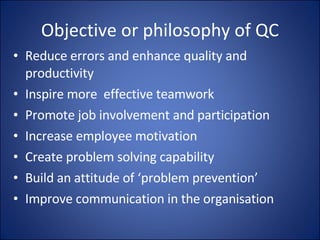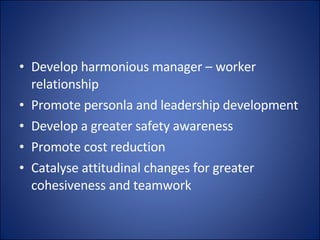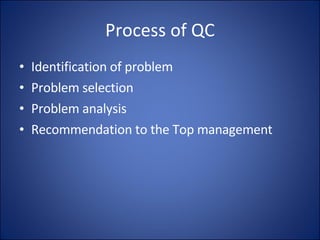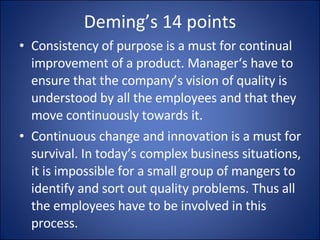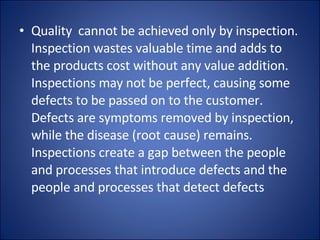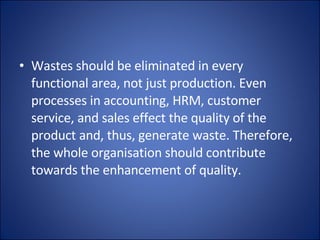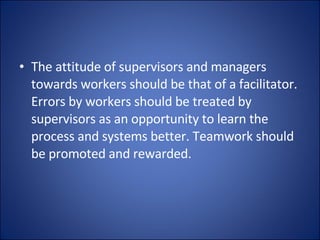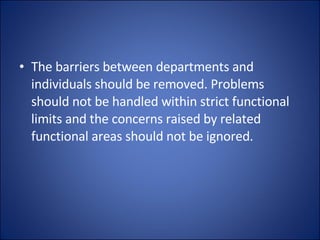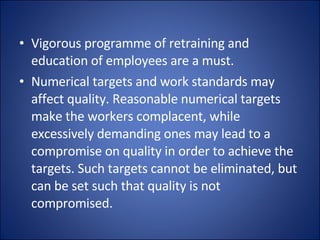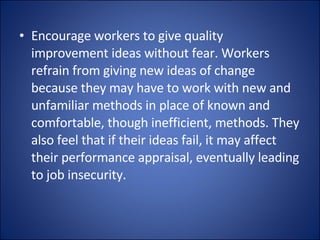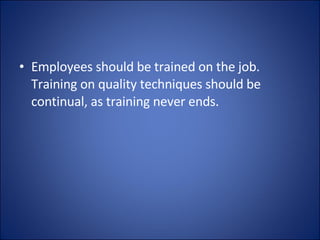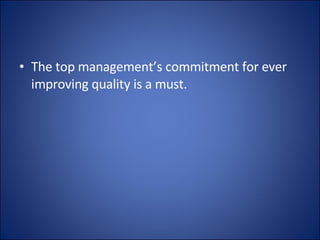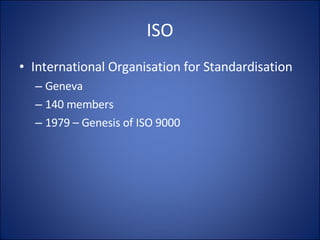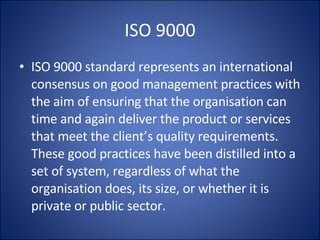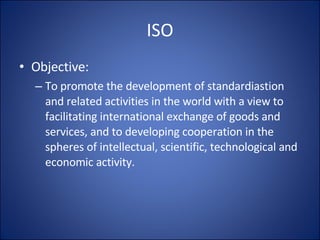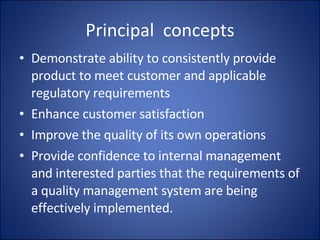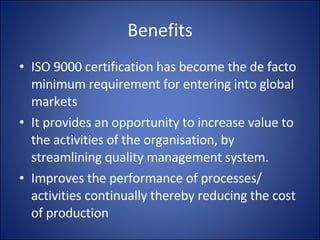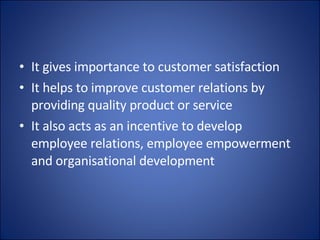Quality Control
- 2. Quality Quality refers to the sum of the attributes or properties that describe a product These are generally expressed in terms of specific product characteristics such as length, width, colour, specific gravity and the like. Performance Conformity to performance standards
- 3. Definition ASQC – Quality means the totality of features and characteristics of a product or service that bear on its ability to satisfy given needs From customer’s perspective, quality of a good or service is fitness for use of it Customer satisfaction for the price of the product
- 4. Quality is a blend of: Fitness of purpose, adequacy of functioning and reliability, for the price paid Design and manufacturing characteristics tailored to meet customer’s requirements during service Availability when required
- 5. Quality control Quality control is a management system for initiating and co ordinating: Quality development, quality maintenance and quality improvement in the various departments of design and manufacturing, for achieving the twin objectives of: Economical production and customer satisfaction
- 6. Objectives of Q C It is to provide products which are dependable, satisfactory and economical To ensure economic production of products of uniform quality acceptable to the customer Aims at preventing the defects rather than detecting the defects
- 7. Need for quality Increased productivity Reduced cost of repairs Increases loyal customer base Better profits
- 8. Quality creation Those activities involved in the selection of the specific characteristics required to achieve the desired quality and the processing or fabrication of materials to conform to the specific characteristics selected. Quality creation involves almost all organisational elements of the enterprise and is the basic objective towards which most activity is directed
- 10. Quality control through Production systems Inputs – Raw materials – acceptance tests- quality of inputs Conversion – production processes-control charts - monitoring quality of partially completed products Outputs- goods & services – acceptance tests- quality of outputs
- 18. Quality control Techniques JIT Quality at source Inspection SQC QC TQM
- 19. JIT JIT helps achieve quality because it is a philosophy that seeks to constantly improve production processes and methods. JIT contributes to high product quality in the following ways Production is highly standardised. Workers perform standard tasks every day. They are familiar with their tasks. Familiarity ensures high quality
- 20. In process inventories are drastically reduced by cutting lot sizes. Any interruption, therefore causes production to stop until the problem has been solved. In this way, JIT has been called a system of enforced problem solving. Now, this stoppage in production forces everybody to solve the quality problem so that the defect will not repeat. Hence high product quality is ensured. Suppliers of materials, under JIT system, supply materials of perfect quality. Many companies do not even inspect suppliers’ deliveries of materials; rather, the emphasis is on working with suppliers to produce perfect parts and materials.
- 21. JIT system envisages the use of automated equipment and robots in production processes. U se of such sophisticated machines will ensure high product quality. JIT system also envisages the use of intensive preventive maintenance programmes in order to prevent any machine breakdown. This results in machines producing parts of perfect quality. Workers are responsible for producing parts of perfect quality or with zero defects before they are passed on to the next production operation.
- 22. Quality at the source The worker is put in the driver’s seat in controlling product quality. The principles underlying quality at the source are: Every worker’s job becomes a quality control station. The worker is responsible for inspecting his own work, identifying any defects and reworking them in to non-defectives, and correcting any causes of defect. Statistical quality control techniques are used to monitor the quality of parts produced at each work station/ and easy-to-understand charts and graphs are used to communicate progress to workers and managers .
- 23. Each worker is given the right to stop the production line to avoid producing defective parts Workers and managers are organised into quality circles- groupes of people who analyse quality problems, work to solve the problems, and implement programmes to improve product quality.
- 24. Inspection The act of determining conformance or non-conformance of the expected performance is the function of inspection. By inspection, a manager seeks to determine the acceptability or non- acceptability of the parts, products or services. The basis for inspection is usually a specification which is called inspection standard. Inspection is made by comparing the quality of the product to the standard.
- 25. Frequency of inspection The challenge is to keep inspection costs minimum, yet realise expected quality. In certain cases every part is inspected, in which case, it is called 100 percent inspection. When it is less than 100 percent , it is called partial or sampling inspection. Parts with high value and those having tendency to run in to large number of rejects are normally subject to 100% inspection.
- 26. When to inspect Inspection is desired at Finished products and parts to know that correct parts are to be assembled or products are right when shipped, Before an expensive processing, The out put of automatic machine periodically so that possible errors are confined to small quantities, and Before an operation that can’t be undone, for example, in mixing paint.
- 27. Where to inspect Crib inspection On line inspection
- 28. Quality Circle It is a participative management concept Though it is in Japan that this was concretised and demonstrated its potential, its rudimentary origin is traced to USA, where problem solving groups have existed since the 1930s. QC – Japan -1960s – Edward Deming & Joseph Juran Dr. Ishikawa – Advisor with JUSE - 1962
- 29. Meaning & Nature QC is a voluntary group of people who meet togethet on a regular basis to identify, analyse and solve quality, productivity, cost reduction, safety and other problems in their work area, leading to improvement in their performance and enrichment of their worklife. Ideal size of QC is around 10 memebers Employee problem solving groups
- 31. Objective or philosophy of QC Reduce errors and enhance quality and productivity Inspire more effective teamwork Promote job involvement and participation Increase employee motivation Create problem solving capability Build an attitude of ‘problem prevention’ Improve communication in the organisation
- 32. Develop harmonious manager – worker relationship Promote personla and leadership development Develop a greater safety awareness Promote cost reduction Catalyse attitudinal changes for greater cohesiveness and teamwork
- 33. Process of QC Identification of problem Problem selection Problem analysis Recommendation to the Top management
- 34. Deming’s 14 points Consistency of purpose is a must for continual improvement of a product. Manager‘s have to ensure that the company’s vision of quality is understood by all the employees and that they move continuously towards it. Continuous change and innovation is a must for survival. In today’s complex business situations, it is impossible for a small group of mangers to identify and sort out quality problems. Thus all the employees have to be involved in this process.
- 35. Quality cannot be achieved only by inspection. Inspection wastes valuable time and adds to the products cost without any value addition. Inspections may not be perfect, causing some defects to be passed on to the customer. Defects are symptoms removed by inspection, while the disease (root cause) remains. Inspections create a gap between the people and processes that introduce defects and the people and processes that detect defects
- 36. Wastes should be eliminated in every functional area, not just production. Even processes in accounting, HRM, customer service, and sales effect the quality of the product and, thus, generate waste. Therefore, the whole organisation should contribute towards the enhancement of quality.
- 37. The attitude of supervisors and managers towards workers should be that of a facilitator. Errors by workers should be treated by supervisors as an opportunity to learn the process and systems better. Teamwork should be promoted and rewarded.
- 38. The barriers between departments and individuals should be removed. Problems should not be handled within strict functional limits and the concerns raised by related functional areas should not be ignored.
- 39. Posters and slogans should be eliminated. These must not be used to tell the workers to work harder. Instead, they should be provided with tools and training so that they work smarter leading to better quality.
- 40. Remove obstacles in the good workmanship of hourly workers to instill a sense of pride in them.
- 41. Vigorous programme of retraining and education of employees are a must. Numerical targets and work standards may affect quality. Reasonable numerical targets make the workers complacent, while excessively demanding ones may lead to a compromise on quality in order to achieve the targets. Such targets cannot be eliminated, but can be set such that quality is not compromised.
- 42. Encourage workers to give quality improvement ideas without fear. Workers refrain from giving new ideas of change because they may have to work with new and unfamiliar methods in place of known and comfortable, though inefficient, methods. They also feel that if their ideas fail, it may affect their performance appraisal, eventually leading to job insecurity.
- 43. Employees should be trained on the job. Training on quality techniques should be continual, as training never ends.
- 44. The lowest price should not be the sole criteria for selecting a supplier. Suppliers asking for lowest prices often offer low quality products, leading to an increase in the overall cost to the buyer due to the increased expenses of inspection, scrap, rework, and inventory to replace defective items, etc. Thus, the supplier offering the lowest total cost should be selected.
- 45. The top management’s commitment for ever improving quality is a must.
- 46. ISO International Organisation for Standardisation Geneva 140 members 1979 – Genesis of ISO 9000
- 47. ISO 9000 ISO 9000 standard represents an international consensus on good management practices with the aim of ensuring that the organisation can time and again deliver the product or services that meet the client’s quality requirements. These good practices have been distilled into a set of system, regardless of what the organisation does, its size, or whether it is private or public sector.
- 48. ISO Objective: To promote the development of standardiastion and related activities in the world with a view to facilitating international exchange of goods and services, and to developing cooperation in the spheres of intellectual, scientific, technological and economic activity.
- 49. Principal concepts Demonstrate ability to consistently provide product to meet customer and applicable regulatory requirements Enhance customer satisfaction Improve the quality of its own operation s Provide confidence to internal management and interested parties that the requirements of a quality management system are being effectively implemented.
- 50. Benefits ISO 9000 certification has become the de facto minimum requirement for entering into global markets It provides an opportunity to increase value to the activities of the organisation, by streamlining quality management system. Improves the performance of processes/ activities continually thereby reducing the cost of production
- 51. It gives importance to customer satisfaction It helps to improve customer relations by providing quality product or service It also acts as an incentive to develop employee relations, employee empowerment and organisational development
